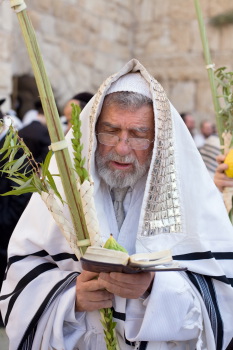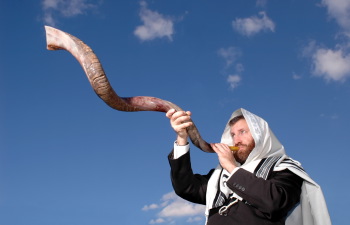Rabbi with Arba'at Ha-Minim.
During the Jewish holiday of Sukkot, one fruit and branches from three plants are waved during a special ceremony that represents service to God.
The current definition of the Jewish calendar is generally said to have been set down by the Sanhedrin president Hillel II in approximately C.E. 359. The original details of his calendar are, however, uncertain.
The Jewish calendar is used for religious purposes by Jews all over the world, and it is the official calendar of Israel.
The Jewish calendar is a combined solar/lunar calendar, in that it strives to have its years coincide with the tropical year and its months coincide with the synodic months. This is a complicated goal, and the rules for the Jewish calendar are correspondingly fascinating.
Lunisolar calendars use months to approximate the tropical year. Examples are the Jewish and Chinese calendars. Since 12 months are about 11 days shorter than the tropical year, a leap month (also called intercalary month) is inserted about every third year to keep the calendar in tune with the seasons. The big question is how to do this. A simple method is to just base it on nature. In ancient Israel, the religious leaders would determine the date for Passover each spring by seeing if the roads were dry enough for the pilgrims and if the lambs were ready for slaughter. If not, they would add one more month. An aboriginal tribe in Taiwan would go out to sea with lanterns near the new moon at the beginning of spring. If the migrating flying fish appeared, there would be fish for New Year’s reunion dinner. If not, they would try their luck next month.
What does a Jewish year look like?
An ordinary (non-leap) year has 353, 354, or 355 days. A leap year has 383, 384, or 385 days. The three lengths of the years are termed, "deficient," "regular," and "complete," respectively.
An ordinary year has 12 months, a leap year has 13 months.
Every month starts (approximately) on the day of a new moon.
The months and their lengths are:
| Name | Length in a deficient year | Length in a regular year | Length in a complete year |
|---|---|---|---|
| Tishri | 30 | 30 | 30 |
| Heshvan | 29 | 29 | 30 |
| Kislev | 29 | 30 | 30 |
| Tevet | 29 | 29 | 29 |
| Shevat | 30 | 30 | 30 |
| Adar I | 30 | 30 | 30 |
| Adar II | 29 | 29 | 29 |
| Nisan | 30 | 30 | 30 |
| Iyar | 29 | 29 | 29 |
| Sivan | 30 | 30 | 30 |
| Tammuz | 29 | 29 | 29 |
| Av | 30 | 30 | 30 |
| Elul | 29 | 29 | 29 |
| Total: | 353 or 383 | 354 or 384 | 355 or 385 |
The month Adar I is only present in leap years. In non-leap years Adar II is simply called "Adar."
Note that in a regular year the numbers 30 and 29 alternate; a complete year is created by adding a day to Heshvan, whereas a deficient year is created by removing a day from Kislev.
The alteration of 30 and 29 ensures that when the year starts with a new moon, so does each month.
What years are leap years?
A year is a leap year if the number year mod 19 is one of the following: 0, 3, 6, 8, 11, 14, or 17.
The value for year in this formula is the ‘Anno Mundi’ described below.
What years are deficient, regular, and complete?
That is the wrong question to ask. The correct question to ask is: When does a Jewish year begin? Once you have answered that question (see below), the length of the year is the number of days between 1 Tishri in one year and 1 Tishri in the following year.
When is New Year’s day?
That depends. Jews have several different days to choose from. The most important are:
1 Tishri: Rosh HaShanah. This day is a celebration of the creation of the world and marks the start of a new calendar year. This will be the day we shall base our calculations on in the following sections.
1 Nisan: New Year for Kings. This is also the start of the religious year. Nisan is considered the first month, although it occurs 6 or 7 months after the start of the calendar year.
Apples and Honey at Rosh Hashana.
The Jewish New Year begins on 1 Tishri, known as Rosh Hashana. Since medieval times, apples and honey have been served at celebratory meals to symbolize a sweet New Year.
When does a Jewish day begin?
A Jewish-calendar day does not begin at midnight, but at either sunset or when three medium-sized stars should be visible, depending on the religious circumstance.
Sunset marks the start of the 12 night hours, whereas sunrise marks the start of the 12 day hours. This means that night hours may be longer or shorter than day hours, depending on the season.
Sounding a Yemenite Shofar.
The shofar is used to announce the new moon, Rosh Hashana, and holidays. A shofar is made from the horn of an animal — typically a ram.
When does a Jewish year begin?
The first day of the calendar year, Rosh HaShanah, on 1 Tishri is determined as follows:
- The new year starts on the day of the new moon that occurs about 354 days (or 384 days if the previous year was a leap year) after 1 Tishri of the previous year.
- If the new moon occurs after noon on that day, delay the new year by one day. (Because in that case the new crescent moon will not be visible until the next day.)
- If this would cause the new year to start on a Sunday, Wednesday, or Friday, delay it by one day. (Because we want to avoid that Yom Kippur (10 Tishri) falls on a Friday or Sunday, and that Hoshanah Rabba (21 Tishri) falls on a Sabbath (Saturday)).
- If two consecutive years start 356 days apart (an illegal year length), delay the start of the first year by two days.
- If two consecutive years start 382 days apart (an illegal year length), delay the start of the second year by one day.
Note: Rule 4 can only come into play if the first year was supposed to start on a Tuesday. Therefore a two day delay is used rather than a one day delay, as the year must not start on a Wednesday as stated in rule 3.
When is the new moon?
A calculated new moon is used. In order to understand the calculations, one must know that an hour is subdivided into 1080 ‘parts’.
The calculations are as follows:
The new moon that started the year AM 1, occurred 5 hours and 204 parts after sunset (i.e. just before midnight on Julian date 6 October 3761 B.C.E.).
The new moon of any particular year is calculated by extrapolating from this time, using a synodic month of 29 days 12 hours and 793 parts.
Note that 18:00 Jerusalem time (15:39 UTC) is used instead of sunset in all these calculations.
How does one count years?
Years are counted since the creation of the world, which is assumed to have taken place in the autumn of 3760 B.C.E. In that year, after less than a week belonging to AM 1, AM 2 started (AM = Anno Mundi = year of the world).
In the year C.E. 2006 we witnessed the start of Hebrew year AM 5767.





